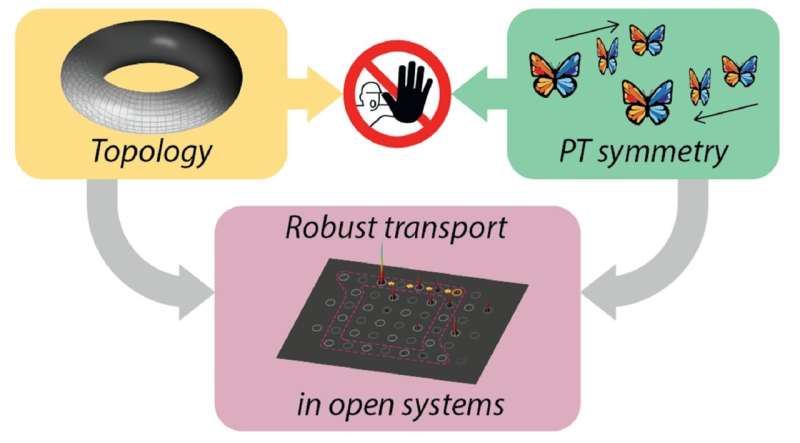This article has been reviewed according to Science X's editorial process and policies. Editors have highlighted the following attributes while ensuring the content's credibility:
fact-checked
peer-reviewed publication
trusted source
proofread
Research team demonstrates robust light propagation in open systems

Physicists from the University of Rostock, the Cluster of Excellence ct.qmat, the Julius-Maximilians University of Würzburg and the Indiana University Indianapolis (IUPUI) have shown for the first time that light can propagate without any loss in systems that interact with their environment. Previously, it was assumed that such open systems inevitably would exhibit exponential amplification or damping of light and thus lead to the instability of the system.
These new results have recently been published in Nature Materials. The findings could become the basis for future development of new robust circuits for electricity, light and sound waves.
Whether describing the orbits of planets or the inner workings of the atom, a key paradigm in physics is the conservation of energy. While different forms of energy may be converted into one another, the total amount of energy is typically assumed to be constant over time. Therefore, physicists usually tend to make sure that the system they are trying to describe does not interact with its environment.
Yet, as it turns out, the dynamics of a system can also be stable if the gain and loss of energy are distributed in a systematic fashion such that they cancel each other out under all conceivable conditions, which can be ensured by so-called parity-time (PT) symmetry.
Similar to a video that is played backwards and simultaneously is reflected in a mirror and yet looks exactly like the original video—i.e., is PT-symmetrical—the components in the system are arranged in such a way that an exchange of gain and loss of light through the simultaneous mirroring and time reversal makes the system appear unchanged.
Far from being a purely academic notion, PT symmetry has paved the way for a deeper understanding of open systems.
The fascinating physical phenomena associated with PT symmetry are the specialty of Professor Alexander Szameit and his team at the University of Rostock. In their custom photonic chips, laser light can mimic the behavior of natural and synthetic materials that are arranged in periodic lattice structures, making them an ideal testbed for a large variety of physical theories.
In this way, Professor Szameit and his team have managed to combine PT symmetry with the concept of topology. Topology studies properties that do not change despite the underlying system being continuously deformed. Such properties then make a system particularly robust against external influences.
For their experiments, Szameit's research group uses laser-inscribed photonic waveguides—optical structures written into a material by a laser beam. In these "circuits for light," so-called topological insulators are realized. Szameit explains, "These insulators have attracted a lot of attention in recent years because of their fascinating ability to convey a lossless stream of electrons or light along their boundary. The unique capability to suppress the impact of defects and scattering makes them particularly interesting for all kinds of technological applications."
However, until now, such robust boundary states were thought to be fundamentally incompatible with open systems. In their joint effort, the researchers from Rostock, Würzburg and Indianapolis were able to show that apparent paradox can be resolved by dynamically distributing gain and loss over time.
First first author, Ph.D. student Alexander Fritzsche, elaborates, "The light propagating along the boundary of our open system is like a hiker traversing mountainous terrain. Despite all the ups and downs, they will inevitably end up back at the initial elevation of the starting point.
"Similarly, the light propagating within the protected edge channel of our PT-symmetric topological insulator will never be exclusively amplified or damped, and can therefore retain its average amplitude while enjoying the full robustness afforded of the topology."
These findings are an important contribution to the fundamental understanding of topological insulators and open systems, and may open the gates to a new generation of advanced circuits for electricity, light or even sound waves.
More information: Alexander Fritzsche et al, Parity–time-symmetric photonic topological insulator, Nature Materials (2024). DOI: 10.1038/s41563-023-01773-0
Journal information: Nature Materials
Provided by University of Rostock





















